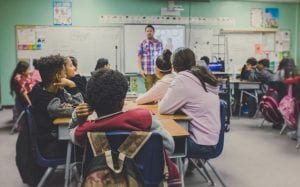
Flipped learning (FL) is a teaching technique which is the reverse of traditional teaching methods. Rather than content taught at school and homework given with FL content is learnt in the students own time and more time in class is available for in-depth help and learning. According to Haddam, McKnight, McKnight, & Arfstrom, 2013) benefits of using this mode of teaching include:
- More class time used to meet student learning needs
- An increase in interaction with the subject by students and with each other
- Increase in job satisfaction for teachers
- Increase in achievement levels
- Better attitude towards learning
However, as Lo and Hew (2017) point out this model can also have problems such as an increased workload for the teacher making videos and student disengagement from too much out of class learning.
The Flipped Learning Network, Pearson and George Mason University have developed themes for the concept around the word ‘flip’ (Haddam, et.al., 2013). They are:
F – Flexible environment – for room arrangement (group and independent) and learning timelines.
L – learning culture – student centred and in class explore topic through student centred activities.
I – Intentional content – choosing which materials to teach and which the student can learn unassisted.
P – Professional educator – observe, give feedback and assess, reflective, open to constructive criticism, connect with other teachers.
It struck me how the qualities listed for professional educator are similar requirements to those listed by Nussbaum-Beach and Hall (2011, p.11) for qualities of a connected educator.
Some experience teachers such as Matt Burns (2018) highly recommend the benefits of the flipped classroom method of learning and has devised a matrix to differentiate student learning based on pretesting and which videos and concepts the students need to watch and master to further their learning. To see more on Matt’s work click here.
I would really like to try the FL approach in a library setting, in particular for skills such as referencing, how to access and use catalogues and demonstrations on how to use digital tools. This would then free up library time to hold indepth discussions and allow for more collaborative or individual work, depending on the learners needs. It would be good if there was a flipped learning lesson video bank so teachers aren’t all making videos on the same concepts, although videos from YouTube, Ted Talks and Khan Academy could be used.
If you are interested in making your own videos Joe Hirsh (2015) has some good tips here on how they can be used effectively.
Have you tried flipping before? What was your experience of it?
References:
Burns, M. (2018, April 28). Maths matrix: differentiated mastery – The Flipped Classroom [blog post]. Retrieved from http://flippingmyprimaryclassroom.blogspot.com/2018/04/maths-matrix-differentiated-mastery.html
Hamdam, N., McKnight, E., McKnight, K., & Arfstrom, K. (2013). The flipped learning model: executive summary. Retrieved from https://flippedlearning.org/wp-content/uploads/2016/07/ExecSummary_FlippedLearnig.pdf
Hirsh, J. (2015). 100 videos and counting: Lessons from a flipped classroom [online article]. Retrieved from https://www.edutopia.org/blog/100-videos-lessons-flipped-classroom-joe-hirsch
Lo, C. K., & Hew, K. F. (2017). A critical review of flipped classroom challenges in K-12 education: possible solutions and recommendations for future research. Research and Practice in Technology Enhanced Learning, 12(1), 4. doi: 10.1186/s41039-016-0044-2.
Nussbaum-Beach, S., & Hall, L.R. (2011). Defining the connected educator. In The connected educator: Learning and leading in a digital age (pp. 9-24). Retrieved from Proquest Ebook Central.
